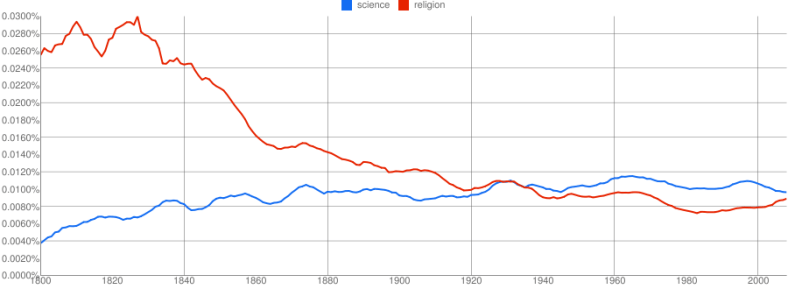Google’s new NGram viewer gives a fascinating look at how memes ebb and flow throughout the years by sharting the appearance of certain words within all the books indexed by Google Books. So far, you can search between 1800 and 2008.
For example, here’s science and religion:

Here’s one that’s really interesting. Looking at the history of the word “magick,” there’s an explosion of interest beginning in the 1980s:

A closer look reveals that the bump that starts an upward trend occurs between 1984 and 1985:

Occurances of the word “occult” have always been much higher, but seems to follow a similar but less exaggerated increase in the 80s and 90s:

“Occult” seems to start rising a little earlier than “magick.” It also declined more sharply in recent years and went through a pronounced trough in the late 90s.
It’s also interesting how popular the word “magick” was in the early 1800s, long before Aleister Crowley started using it. But it’s never been as popular as magic with a c:

Note the cute little devil horns! (This could be due to scanning issues – see Danny Sullivan’s commentary here).
A few notes:
Michelle Remembers (the book that helped start the Satanic Panic) was released in 1980 and Falcon Publishing started around that year.
Some of Llewellyn‘s biggest hits like Wicca and Modern Magick didn’t come out in the late 80s, but the publishing house has been around since the 1901 (founded in Portland, incidentally). According to Wikipedia, the company started publishing authors like Dion Fortune and Aleister Crowley in the 60s. The other big publisher of occult and new age books, Weiser, was founded in 1956 – also well before the 80s explosion.
McMartin preschool trial started in 1983 and through the 1987. This probably contributed significantly to number of books published on magick and the occult during this period.


